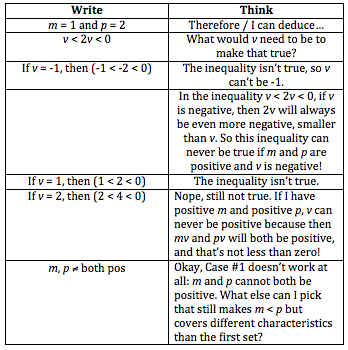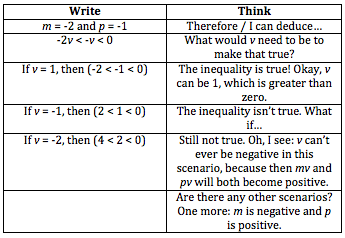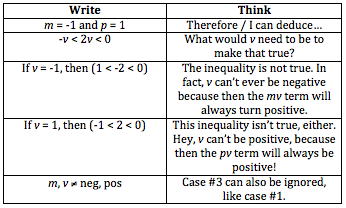-
Target Test Prep 20% Off Flash Sale is on! Code: FLASH20
Redeem
The 4 Math Strategies Everyone Must Master - Part I
 We need to know a lot of different facts, rules, formulas, and techniques for the quant portion of the test, but there are 4 math strategies that can be used over and over again, across any type of mathalgebra, geometry, word problems, and so on.
We need to know a lot of different facts, rules, formulas, and techniques for the quant portion of the test, but there are 4 math strategies that can be used over and over again, across any type of mathalgebra, geometry, word problems, and so on.
Do you know what they are?
Try this GMATPrep problem and then well talk about the first of the four strategies.
* If mv < pv < 0, is v > 0?(1) m < p
(2) m < 0
All set?
How did you do the problem? Most quant questions have more than one possible approach and this one is no exceptionbut I want to use this problem to talk about a particular technique called Testing Cases.
This question is called a theory question: there are just variables, no real numbers, and the answer depends on some characteristic of a category of numbers, not a specific number or set of numbers. When we have these kinds of questions, we can use theory to solvebut that can get very confusing very quickly. Instead, try testing real numbers to prove the theory to yourself.
(Note: I chose a particularly tough question for this exercise; testing cases can also be useful and fast on easier questions!)
This problem gives one inequality:
"mv < pv < 0"
The test writers are hoping that youll say, Oh, lets just divide by v to get rid of it, so the equation is really m < p < 0. But thats a trap! Why?
When you divide an inequality by a negative, you have to flip the signs. But you dont know whether v is positive or negative, so you dont know whether to flip the signs! Never divide an inequality by a variable if you dont know the sign of the variable.
The question itself contains a clue (two, actually!) pointing to this trap. The given inequality asks about < 0 and the question also asks whether v > 0? Less than zero and greater than zero are code for Im testing you on positives and negatives.
So, we cant actually simplify that annoying inequality. Things are going to get a little messy, but can you figure anything out to start? Glance at that starting inequality for a second: what cant the value be? None of the variables can be 0, or the inequality mv<pv< 0would be false.
Do you want to start with statement 1 or statement 2? Since Im writing this, I get to choose (I want to start with statement 2), but there isnt one right answer to that question. Start wherever you want!
(2) m < 0
Hmm, m is negative. Call that -1. Then v could be -1 oh, wait, no v cant be negative. Then mv would be positive but mv is supposed to be less than 0. And I already said v cant be 0. If m is negative, then the only way to make mv negative is to make v positive. Cool!
Ive just proven the theory to myself by using a concrete number: I want mv to be negative. A negative times a positive equals a negative. If m is negative, then v has to be positive.
Statement 2 is sufficient. Cross off answers ACE.
(1) m < p
(This one gets messy: I suggest you write down the steps yourself as we go.)
Case #1: positive / positive.
Case #2: negative / negative.
Case #3: negative / positive.
The only scenario that worked was case #2, and the only values for v that worked were positive. Therefore, v is greater than zero; the statement is sufficient.
The correct answer is (D).
As I mentioned earlier, the Testing Cases strategy can be used to make the work faster on lots of easier problems as well. In the case of these annoying theory questions, Testing Cases can really save us by making it (somewhat) easier to figure out whats going on with the theory.
For Strategy #2, Im going to send you to an article I wrote a long time ago: How to Turn Algebra into Arithmetic. (We officially call this strategy Choose Smart Numbers.)
This classic Problem Solving (PS) strategy has been around since the beginning of time (well, Standardized Test Time, anyway). It will work only on Problem Solving questions, not Data Sufficiency, but it is based on a similar principle: pick some real numbers to turn annoying algebra / variables / abstract math into a much more concrete problem.
One main difference exists between the two strategies discussed so far. When choosing smart numbers, you will only have to test one set of numbers in the problem. When testing cases on theory problems, you will almost certainly have to test multiple sets of numbers (as we did in the problem above).
Okay, begin! Ill start you out with a couple of easier ones from OG13. Note: always learn new techniques on easier problems first! You might not even choose to use the special technique on this problem during the real test, but thats the point: you'll learn how to use the technique more easily when you already understand how the textbook math works.
Test Cases: PS #32, PS #44, DS #1, DS #7
Choose Smart Numbers: PS #34, PS #38
Start thinking about how to recognize when you can use these strategies (how do you know?), and then practice them in different scenarios and across different content categories. Eventually, you will master these 2 essential techniques!
Finally, dont forget to join me next time, when well discuss the other 2 essential quant techniques that everyone must master.
* GMATPrep questions courtesy of the Graduate Management Admissions Council. Usage of this question does not imply endorsement by GMAC.
Recent Articles
Archive
- April 2024
- March 2024
- February 2024
- January 2024
- December 2023
- November 2023
- October 2023
- September 2023
- July 2023
- June 2023
- May 2023
- April 2023
- March 2023
- February 2023
- January 2023
- December 2022
- November 2022
- October 2022
- September 2022
- August 2022
- July 2022
- June 2022
- May 2022
- April 2022
- March 2022
- February 2022
- January 2022
- December 2021
- November 2021
- October 2021
- September 2021
- August 2021
- July 2021
- June 2021
- May 2021
- April 2021
- March 2021
- February 2021
- January 2021
- December 2020
- November 2020
- October 2020
- September 2020
- August 2020
- July 2020
- June 2020
- May 2020
- April 2020
- March 2020
- February 2020
- January 2020
- December 2019
- November 2019
- October 2019
- September 2019
- August 2019
- July 2019
- June 2019
- May 2019
- April 2019
- March 2019
- February 2019
- January 2019
- December 2018
- November 2018
- October 2018
- September 2018
- August 2018
- July 2018
- June 2018
- May 2018
- April 2018
- March 2018
- February 2018
- January 2018
- December 2017
- November 2017
- October 2017
- September 2017
- August 2017
- July 2017
- June 2017
- May 2017
- April 2017
- March 2017
- February 2017
- January 2017
- December 2016
- November 2016
- October 2016
- September 2016
- August 2016
- July 2016
- June 2016
- May 2016
- April 2016
- March 2016
- February 2016
- January 2016
- December 2015
- November 2015
- October 2015
- September 2015
- August 2015
- July 2015
- June 2015
- May 2015
- April 2015
- March 2015
- February 2015
- January 2015
- December 2014
- November 2014
- October 2014
- September 2014
- August 2014
- July 2014
- June 2014
- May 2014
- April 2014
- March 2014
- February 2014
- January 2014
- December 2013
- November 2013
- October 2013
- September 2013
- August 2013
- July 2013
- June 2013
- May 2013
- April 2013
- March 2013
- February 2013
- January 2013
- December 2012
- November 2012
- October 2012
- September 2012
- August 2012
- July 2012
- June 2012
- May 2012
- April 2012
- March 2012
- February 2012
- January 2012
- December 2011
- November 2011
- October 2011
- September 2011
- August 2011
- July 2011
- June 2011
- May 2011
- April 2011
- March 2011
- February 2011
- January 2011
- December 2010
- November 2010
- October 2010
- September 2010
- August 2010
- July 2010
- June 2010
- May 2010
- April 2010
- March 2010
- February 2010
- January 2010
- December 2009
- November 2009
- October 2009
- September 2009
- August 2009


